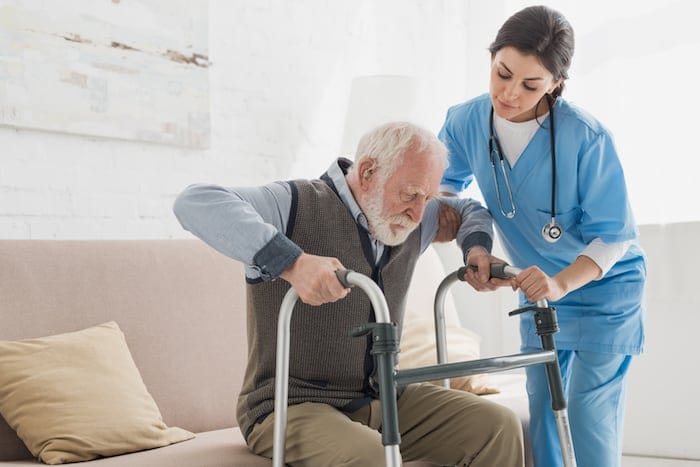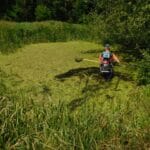The overuse injury of the Achilles (uh-KILL-EEZ) tendon is known as Achilles tendonitis. The Achilles tendon is the body’s largest tendon that connects the heel to calf muscles and is of two types:
- Insertional Achilles tendonitis: this affects the lower part of the tendon. It is the place where the tendon attaches to the heel bone.
- Noninsertional Achilles tendonitis: this involves the tendon’s middle part. The condition affects younger and active people the most.
Tearing of this tendon comes to the eyes of patients through several symptoms.
It is a common problem in runners when they increase their running intensity or duration. Mid-aged people who usually indulge in basketball or tennis are the most affected by this condition. Furthermore, Achilles Tendon becomes weak with age or medical conditions like diabetes.
Cases occur in people who are at least 40 years of age. Yes, the elderly suffer from chronic Tendonitis the most due to elasticity loss in tendons.
Thus, it becomes necessary to turn attention to painful tendons with diligence. After all, it’s about taking a restorative action right away.
Additionally, this condition occurs with sudden or unexpected falls or curb step-offs. Medical professionals suggest meeting a podiatrist to discuss the best treatment options available.
What are the Symptoms of the Condition?
Gradual pain is the main symptom of Achilles tendonitis. The problem builds up and worsens with time. Additionally, individuals may notice the following symptoms:
- Tendon soreness from a few centimeters where it meets the heel bone.
- The feeling of stiffness, slowness, or weakness towards the lower leg.
- The experience of slight pain in the back of the leg, which becomes severe after running or exercising.
- Increase in pain during climbing of stairs.
- Swelling or lump-like formation in the Achilles tendon.
- Creak-like experience while moving or touching.
How to Know if your Elderly is Suffering from Achilles Tendonitis?
It’s time to visit a podologist once you/ your elderly notice the symptoms mentioned above. They’ll first perform a physical exam, wherein the doctor looks for tenderness. The pain and tenderness are usually along the tendon area when you stand on your toes.
Get an X-Ray done as it will help with diagnosing the bone problems. An MRI scan works if you’re considering surgery or for evaluating the tear in the Achilles tendon.
What’s the treatment for the condition?
Now that you know the problem, taking steps for its treatment is essential.
The primary aim of treatment is to reduce swelling and relieve pain. Measures usually depend upon the severity of the condition. Doctors check if the patient experiencing Achilles Tendonitis is a professional athlete or not. Then, he/she suggests a combination of strategies as treatment. These may be:
- Ice packs: Pain and inflammation can ease to unexceptional levels with ice packs.
- Rest: Resting gives tissue enough time to heal. Usually, the type of rest depends upon the severity of the conditions. In mild cases, doctors may recommend the senior to reduce the exercise time. But complete rest for weeks or days at a stretch is recommended in severe cases.
- Elevating the foot: Swelling can reduce after you keep the foot raised above the heart’s level. Doing so will cut swelling.
- Pain relief: Nonsteroidal anti-inflammatory drugs (NSAIDs) like ibuprofen can reduce swelling and pain. People with kidney disease, asthma, or liver diseases should check with their doctor.
- Steroid injections: Cortisone works in reducing tendon swelling. Yet, the problem reduces the risk associated with tendon rupture when you give an injection.
- Orthotic devices and compression bandages: Shoe inserts and ankle supports help with the healing process. It is because these take off the tendon stress. Heel lifts also work wonders. They help in moving the foot away from the back of the shoe.
- Extracorporeal shockwave therapy (ESWT): Podiatrists use high-energy shockwaves for stimulating the healing process. Although, the results aren’t consistent. Yet, it is reliable when other measures do not work. And, why not? These are worth trying before opting for surgery.
The treatment takes from around a few days to six weeks, according to a Trusted Source.
8. Surgery: The last option for repairing tendon-sustained damage is surgery. The American Academy of Orthopedic Surgeons recommends surgery only if the pain continues for more extended periods. These may be for six months or more.
Gastrocnemius recession is the most common procedure. This process involves lengthening around one or two muscles that make up the calf. Also, the ankle gains a broader range of motion.
9. Stretches and Exercises: Doctors recommend physiotherapy as a solution to Achilles Tendonitis. A physiotherapist teaches stretching exercises to improve flexibility and increase calf strength.
The main exercises that one should practice are:
Calf stretch:
- Place your hands against the wall or a stiff object and lean forward.
- Take one foot on the ground, keeping your leg straight—the other foot in the front with your knee bent.
- Push your hips towards the wall. Hold the position for not less than 10 seconds.
- Relax and repeat the process 20 times for each foot.
Bilateral heel drop:
- Keep the front half of your foot on the stair. Keep your heel off, and grip your rail to ensure a sound balance.
- Lift your heels. Now lower them as far as you can.
- Repeat the exercise 20 times.
Tip: Keep the pace of these exercises slow and controlled. After all, you don’t want to increase the damage by doing them fast.
These exercises and other preventive measures help with healing and preventing future injury. Usually, physiotherapy is the most effective for noninsertional Achilles tendonitis.
How do you Avoid Tendonitis in the First Place?
The body’s way of telling us to take a break is the occurrence of pain.
For instance, when your elderly feel pain while gardening, ensure they take an off for an hour or two. Even after taking a break, the occurrence of extended pain is a sign of a persistent problem. And, this needs rest for a few days or a doctor’s help.
Reduce the risk of Tendonitis by employing limited force and repetitions. Additionally, ensure the seniors build up their activity levels. Yes, consider something new instead of going full-force.
Who are the People with the Most Risk?
Aside from age being the only factor, people suffer from Tendonitis because of other conditions.
Individuals who have a thyroid disorder, rheumatoid arthritis, or psoriatic arthritis are also at risk. In some cases, a cat bite or dog bite can be the cause of Tendonitis. As mentioned above, some of the best ways of helping seniors can be rest and icing.
Consider hiring a caregiver if your loved one needs help with household chores like cooking or housekeeping.
Final Words: Maintaining Mobility
One of the significant factors for remaining a vital part of society is the ability to stay mobile.
At one age, retaining ambulation relates directly to foot health. With ambulation impairing, even the most active seniors transform into dependent individuals. Thus it becomes essential to identify foot problems that associate with pain.
One such aid can be a pharmacologist whose advice on lifestyle can work wonders in improving functional ability. After all, it’s all about maintaining sound physical and mental health while aging.
Senior Outlook Today is your go-to source for information, inspiration, and connection as you navigate the later years of life. Our team of experts and writers is dedicated to providing relevant and engaging content for seniors, covering topics such as health and wellness, finances, technology and travel.






